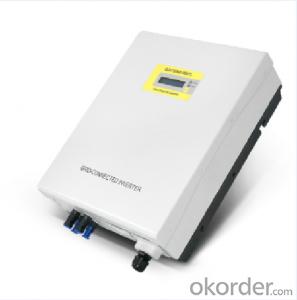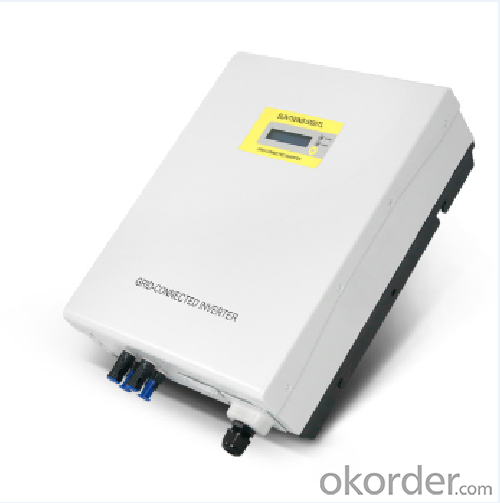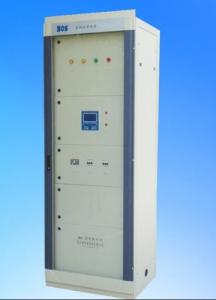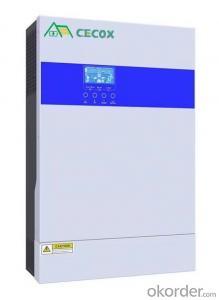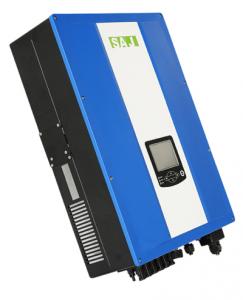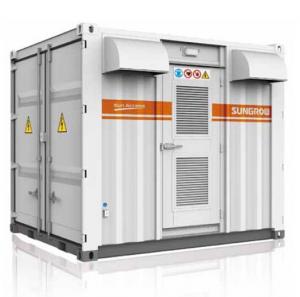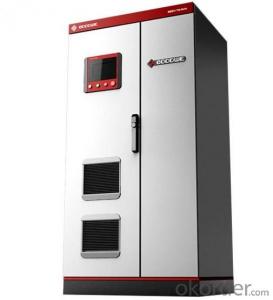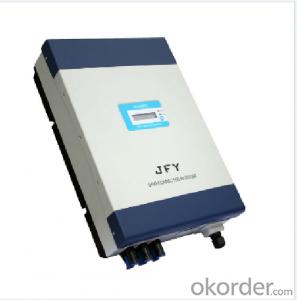Micro Solar Inverter 5kW 2MPPTs 5000TL On-Grid Inverter
- Loading Port:
- Qingdao
- Payment Terms:
- TT OR LC
- Min Order Qty:
- 50000 watt
- Supply Capability:
- 3000000 watt/month
OKorder Service Pledge
OKorder Financial Service
You Might Also Like
1. Structure of Solar On-grid Inverter 5kw 2MPPTs 5000TL Description
A solar inverter, or PV inverter, or Solar converter, converts the variable direct current (DC) output of a photovoltaic (PV) solar panel into a utility frequency alternating current (AC) that can be fed into a commercial electrical grid or used by a local, off-grid electrical network. It is a critical BOS–component in a photovoltaic system, allowing the use of ordinary AC-powered equipment. Solar inverters have special functions adapted for use with photovoltaic arrays, including maximum power point tracking and anti-islanding protection.
2. Main Features of the Solar On-grid Inverter 5kw 2MPPTs 5000TL
﹒2 MPPT channels, new generation technology
﹒Two high speed MPPT for real time power tracking and improved energy harvesting
﹒High frequency transformer operation for highest efficiency: 97.4% (97.0% Euro)
﹒Certified grid connected operation according to the international standards
﹒True Sine Wave Output
﹒ Integrated RS-485/RS-232 serial communication
﹒Multi-language display
﹒2 MPPT channels can be independent or parallel, auto detecting operation
3. Solar On-grid Inverter 5kw 2MPPTs 5000TL Images
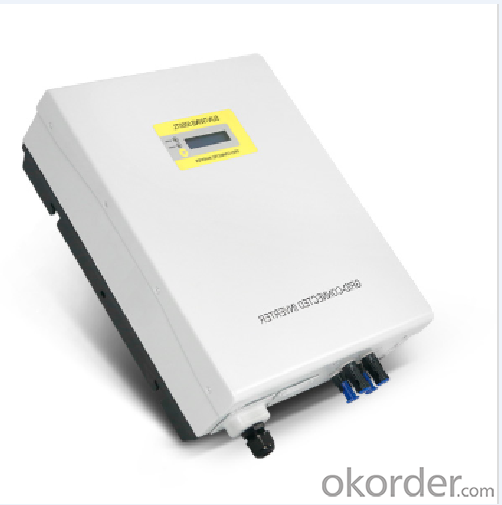
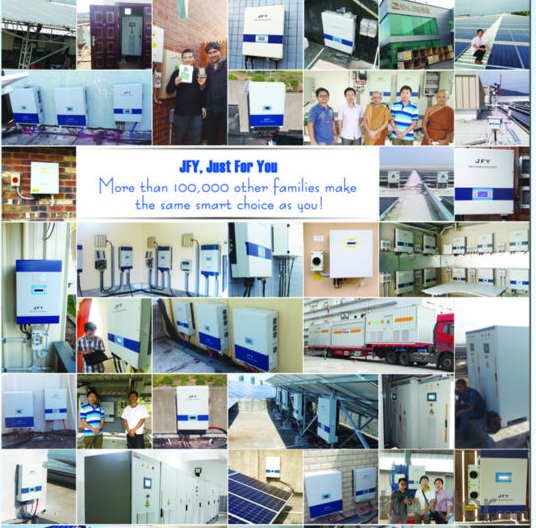
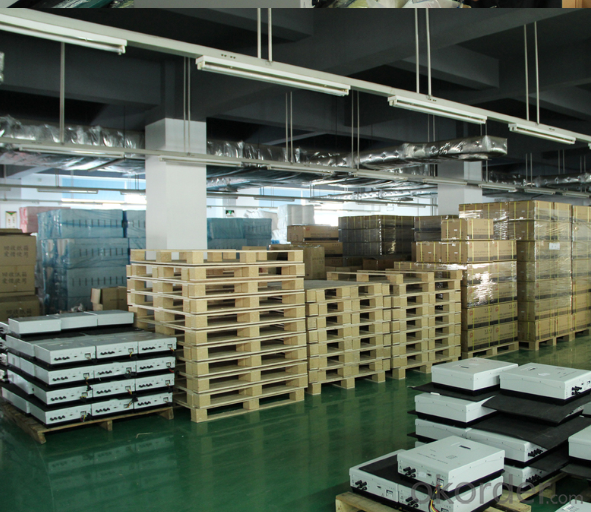

4. Solar On-grid Inverter 5kw 2MPPTs 5000TL Specification
CHARACTERISTICS | Suntwins 5000TL |
Input Data(DC side) | |
Max. DC power(Total) | 5300W |
Max.DC power per MPPT | 3000W |
Max. DC voltage | 500Vdc |
MPPT Operating range | 100~450Vdc |
Number of parallel inputs | 2 |
Number of MPPT trackers | 2 |
Max. input current per MPPT | IN1:15A/IN2:15A |
Output Data(AC side) | |
Nominal output power | 4950W |
Max. Output power | 4950W |
Nominal output current | 21.5A |
Max. output current | 25A |
Nominal AC voltage | 230Vac |
AC voltage range * | 190~265Vac |
Nominal AC grid frequency | 50Hz |
AC grid frequency range* | 50 ± 5 Hz |
Power factor(cos φ) | >0.99 |
Harmonic distortion(THDI) | <3%(at nominal output power) |
Efficiency | |
Max. efficiency | 97.4% |
Euro efficiency | 97.0% |
MPPT efficiency | 99.6% |
Genaral data | |
Dimensions (W / D / H) | 345*152*435mm |
Net weight | 18Kg |
Operating temperature range | –25 °C ~ +60 °C |
Noise emission (typical) | ≤ 25 dB(A) |
Power consumption at night | 0 W |
Electrical isolation | No |
Cooling concept | Natural cooling |
IP Code | IP65 |
Communication | RS-232(RS485 is optional) |
5. FAQ of Solar On-grid Inverter 5kw 2MPPTs 5000TL
Q1. What is the difference between inverter and solar inverter?
A1. Inverter only has AC inpput, but solar inverter both connect to AC input and solar panel, it saves more power.
Q2. What is the difference between MPPT&PWM?
A2. MPPT has higher efficiency, it can track the max power point and won't waste energy.
Q3. What is the waranty of product?
A3. 12 months.
- Q: Can a solar inverter be used with solar trackers?
- Yes, a solar inverter can be used with solar trackers. Solar trackers are used to maximize the efficiency of solar panels by orienting them towards the sun. Solar inverters are responsible for converting the DC power generated by solar panels into usable AC power. Both components work together to optimize solar energy production.
- Q: Can a solar inverter be used in areas with frequent power outages?
- Yes, a solar inverter can be used in areas with frequent power outages. Solar inverters have the ability to convert the direct current (DC) power generated by solar panels into alternating current (AC) power that can be used to operate electrical devices. During power outages, the solar inverter can continue to provide electricity from the solar panels, allowing for uninterrupted power supply. However, it is important to note that a battery storage system may be required to store excess solar energy for use during periods of low sunlight or at night when the solar panels are not producing electricity.
- Q: How is the efficiency of a solar inverter measured?
- The efficiency of a solar inverter is typically measured by dividing the output power of the inverter by the input power, and then multiplying the result by 100 to get a percentage value.
- Q: How does a solar inverter handle voltage phase imbalance in the grid?
- A solar inverter handles voltage phase imbalance in the grid by continuously monitoring the grid's voltage and frequency. If it detects any phase imbalance, it adjusts its output to balance the voltage across all phases. This ensures that the power generated by the solar panels is synchronized with the grid and prevents any issues that may arise due to phase imbalances, such as equipment damage or power quality issues.
- Q: Can a solar inverter be connected to a smart home or monitoring system?
- Yes, a solar inverter can be connected to a smart home or monitoring system. Many modern solar inverters have built-in communication capabilities, such as Wi-Fi or Ethernet connectivity, which allows them to connect to a smart home or monitoring system. This enables users to monitor and control their solar power generation and energy consumption remotely, receive real-time data and alerts, and optimize their energy usage for maximum efficiency.
- Q: What is the role of a DC-DC converter in a solar inverter?
- The role of a DC-DC converter in a solar inverter is to convert the direct current (DC) generated by the solar panels into the appropriate voltage and current levels required for the inverter to convert it into alternating current (AC) electricity. The DC-DC converter ensures efficient power transfer and enables the solar inverter to maximize the energy harvested from the solar panels. Additionally, it helps regulate the voltage levels and maintain the stability of the solar power system.
- Q: How is the output voltage and frequency of a solar inverter regulated?
- The output voltage and frequency of a solar inverter are regulated through a combination of control systems and power electronics. The control system continuously monitors the input from the solar panels and adjusts the inverter's operation accordingly. It analyzes the DC voltage generated by the panels and converts it to AC voltage at the desired frequency. This is achieved by controlling the switching of power electronic devices such as transistors or thyristors. These devices convert the DC power into high-frequency AC power, which is then transformed to the desired output voltage and frequency through a transformer or filter circuit. Overall, the regulation of the output voltage and frequency is achieved by the precise control of these power electronic components within the solar inverter.
- Q: What is the role of MPPT (Maximum Power Point Tracking) in a solar inverter?
- The role of MPPT (Maximum Power Point Tracking) in a solar inverter is to optimize the power output from a solar panel by continuously tracking and adjusting the operating point to ensure it operates at the maximum power point. This is crucial because the power output of a solar panel is affected by various factors such as temperature and shading, and without MPPT, the inverter would not be able to extract the maximum power from the panel, leading to reduced efficiency and output. MPPT algorithms monitor the voltage and current of the solar panel and adjust the load to match the optimal operating voltage, maximizing the power output and overall system performance.
- Q: How does MPPT improve the efficiency of a solar inverter?
- MPPT, or Maximum Power Point Tracking, improves the efficiency of a solar inverter by constantly adjusting the operating voltage and current to maximize the power output of the solar panels. This optimization ensures that the inverter extracts the maximum available power from the solar panels, thereby increasing overall system efficiency and maximizing the energy harvest from the solar installation.
- Q: How does a solar inverter affect the overall system reliability?
- A solar inverter plays a crucial role in the overall system reliability of a solar power system. It converts the direct current (DC) generated by solar panels into alternating current (AC) that is compatible with the electrical grid. By efficiently and accurately converting the power, a high-quality solar inverter ensures optimal energy production and grid integration. It also helps in voltage regulation, frequency control, and protection against grid faults. Therefore, a well-functioning and reliable solar inverter significantly enhance the overall system reliability, maximizing the overall efficiency and longevity of the solar power system.
Send your message to us
Micro Solar Inverter 5kW 2MPPTs 5000TL On-Grid Inverter
- Loading Port:
- Qingdao
- Payment Terms:
- TT OR LC
- Min Order Qty:
- 50000 watt
- Supply Capability:
- 3000000 watt/month
OKorder Service Pledge
OKorder Financial Service
Similar products
Hot products
Hot Searches
Related keywords
